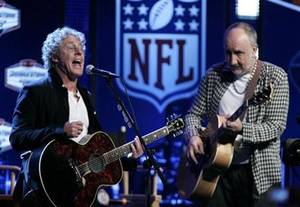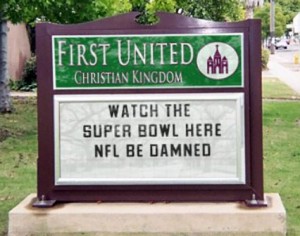About the (w)hoopla: A few pedagogical thoughts about the Super Bowl ritual.

Forty four years strong with no indication of letting up, the Super Bowl is only rivaled by A Christmas Story and It’s A Beautiful Life as ritual viewing in United States television. Overnights show that this year’s contest was a truly massive affair as Nielsen reported that it beat the M*A*S*H finale as the most-watched program in television history. Impressive as this is, I am always impressed more by how socially contentious the program is. Please note, I said program, not game. Sarah Jedd’s piece about the hype surrounding Focus on the Family’s “Tim Tebow Ad” is indicative of the debate concerning what should compose this televisual corpus. The least visually interesting ad of the night, the commercial’s politics became visible because of the hype. It’s obstensive message of “Celebrate Family, Celebrate Life” is hardly controversial. In fact, if you had not been looking for the ad, you would have probably missed it. I had to rewatch the ad online because I simply missed it when it was on and, yes, I had expected it.
Less political but just as contentious in some quarters was the inclusion of The Who as the halftime act. There are a number of reasons for this debate, including the fact that The Who haven’t recorded and released any new music since 2005, and nothing of any cultural consequence since the early 1980s. As a longstanding staple of classic rock radio, the choice of The Who raised the eyebrows of many Internet critics and Twitterers. Watching the debate I couldn’t get over the fact that the children of “My Generation” were skewering one of their parent’s most iconic bands for being “out of touch”. I don’t know who should be playing the halftime show of the Super Bowl, but as far as rites go, The Who and the Super Bowl fit as well as you could expect. As comfortable as your dad/older brother’s well-worn copy of Quadrophenia, they are one of the very few musical acts in the world that a majority of the program’s listeners could say, “Yeah, I’ve heard of them at least once”.
This kind of mass recognition is the the point of Super Bowl programming, after all. In an era of fragmentation it’s the only media program left that has any kind of mass ritual component. Which, of course, is not only why so many debate its contents but why and how we , as scholars, should approach the program. So here’s a few suggestions for media scholars and educator’s approaching next year’s event:
1) For those teaching media industries: even if you hate football and cannot stomach the thought of watching the Super Bowl, lead your students through a counterprogramming exercise. Even to the most inexperienced, it will become apparent that everything from television to local film theaters must acknowledge the presence of the 800 pound gorilla that will be SB XLV and allow you to drive home a number of points about media audiences and how media industries envision their composition and behaviors.
2) For those taking an anthropological or sociological slant on the games: A week before the game walk your students through local media sources in search of collective viewing options. This will allow you to illustrate how the program acts as a catalyst for explicit collective pleasures. See how churches, union halls, and other organizations use it as a moment to play together and ask them to discuss its importance to these groups. Also lead them to controversies where the NFL has shut down these parties and ask them to discuss how organizations vie for audiences. It will allow your students to better understand media programming act as explicit moments of sociality that sometimes confront other legal and financial aims.
3) For those teaching from a cultural studies point of view: After the program, ask students to list all of the debates that students participated in, both on and offline. If Janet Jackson and Tim Tebow have taught us anything, the Super Bowl is a moment where the connection between culture and politics become explicit. Use the opportunity in class to reiterate the most basic of cultural studies aims and make it clear that even if you didn’t watch the program, the fact that you could not avoid it may be the most interesting path of debate for scholars and students alike.





The Who play the opening theme for CSI and all of the spin-offs. The selection of that band was the largest and most boring CSI ad of all time.
At the party I attended (full of media scholars), someone commented, “I’m surprised they’re playing ‘Who Are You?’ What an odd choice.” And then there was a chorus of, “CSI: theme!” In the original commenter’s defense, though…I don’t think he’s a big fan of broadcast net procedurals.
This is an interesting post and, more importantly, a timely reminder of the cultural significance of the Super Bowl. I particularly enjoyed your comments on The Who’s performance. While I thought that their set was underwhelming, one cannot deny that the group has the songs and the legacy to fill this most massive of stages. As you astutely point out, this is one of the few groups out there that can unite the variegated Super Bowl audience in familiarity, if not in taste. For what it’s worth, I sampled a number of excellent Who youtube performances in the lead-up to Sunday’s performance and, while I didn’t much care for that tepid outing, I am grateful to the Super Bowl for reminding me of just how visceral and punishing The Who were up until the very recent past.
All that said, I wonder now whether the NFL will eventually return to a more creative and adventuresome Super Bowl halftime entertainment line-up. The Nipslip fiasco is receding into the past now and even this most conservative of sports leagues must recognize that this stage deserves a more contemporary spectacle. I recall Super Bowl 35 when MTV put together a show that saw Aerosmith collaborate with N’Sync, Mary J. Blige, Nelly, and Britney Spears, and others on an impeccably choreographed presentation that would not have occurred in any other context (youtube link below). How great would this year’s show have been had a reduced Who’s set book-ended a Beyonce centre? I understand that the NFL is reluctant to once again relinquish control of the program, but surely they could find a way to satisfy all viewer constituencies while injecting a bit more life and variety into the halftime proceedings. If they were able to do this, they might be able to steal some viewers back from the Puppy Bowl and its Kitty halftime show.
http://www.youtube.com/watch?v=_-oJKyHHxKk
And here’s a conundrum: only 5 of my 25 students even viewed the Super Bowl, as Sundays are for homework. I played the most controversial ads in class, but it’s hard to recreate context. Small, insular communities (like the small liberal arts school where I teach) make for few parties; at a larger school, or, heck, one that has a football team, many students go home or watch with larger groups, not all of whom are necessarily students. Definitely not the case here — most of my students admit to not even having access to a television proper in the space in which they live. KIDS THESE DAYS!
I have to say that your experience is exceptional. Even the Liberal Arts school I used to teach at you would have a much larger response rate than 20 percent to super bowl viewing. Are their other external elements that would make for such a low response rate or are all of your students so diligent?
I think part of it is diligence. They study hard, and when I attended this particular school, I think I only watched The Super Bowl two out of four years. But these are also kids in a television class, so I thought the percentage would be higher. For me, brings home the fact that so many of them either don’t watch TV at all….or watch it exclusively using their computers.
“In an era of fragmentation it’s the only media program left that has any kind of mass ritual component”
Maybe in the US, and I realize that was the frame you were discussing, Tim. But Hockey Night in Canada, for instance, still enjoys remarkable viewership, and I’d be intrigued to hear what other, non-sport media rituals are still going strong elsewhere. Anyone?
Even if there are no other successful media rituals, it’s important to acknowledge that networks love SELLING things as mass rituals: NBC tried to argue that Leno was going to become appointment viewing, which was entirely ridiculous but shows that they want to give the impression that their programming could reach the level of ritual.
I’d argue, though, that if we ignore the “mass” side of things, Late Night remains the closest thing in primetime (Price is Right, Oprah, etc. could qualify in daytime, of course).
The schedule of the day is a sort of daily rite, no doubt. This is one of the reasons why Leno failed at 10pm. No doubt his show was poorly written and conceived, but it also challenged what has become a daily set of rites: Talk comes on after the news, thank you very much.
Jonathan, I thought I had couched this US portion of this in an earlier sentence. I would never assume that this is the only one left in the world. That wasn’t my point. I would like to see a great essay about Hockey Night in Canada. I love Don Cherry and his Europhobic tirades as much as the next guy. But even then, does it reap an almost 50 rating in Canada? I would think the Canadian hockey team in Vancouver may.
To be clear, I wasn’t wagging the “boo, American-centric” finger at you, Tim 😉 Just speculating as to what else out there in the world works in similar ways.
I figured, but it is an interesting question especially this year given that both the Winter Games and the World Cup are on tap. I am bit out of touch of recent Global Media literature, so I wonder where the discussions re nationalism and media are occurring today. It was a dominant topic in the mid-1990s and, for a while, there was a “post-nationalist” discourse that seemed to pop up around a number of shows and production units. Still, it seems to me that this would be a place to engage those questions.
Another key synergistic point about The Who – they provide the theme songs for the blockbuster CBS CSI franchise, and all three of those songs were featured at the CBS-aired Super Bowl. And I’m sure many viewers contextualized the band through those 1-minute credit snippets rather than classic rock radio.
I’m quite surprised that CBS didn’t force David Caruso to introduce the band with a bad sunglasses pun, followed by the Daltry scream…
Jason, that could be the case, but The Who’s catalog is so well digested in American music culture it would be impossible to locate all of the spaces where it is available. Michael Moore films, CSI franchises, your mechanic’s garage, I find it difficult to specifically locate them. Perhaps I am unique that way, but The Who seem slippery to me. Technically a 60s band, they really didn’t become huge until the 70s and even then they sounded more like an 80s band (all of those synths on Who’s Next).
Anyways, that’s me just thinking out loud. For what it is worth, did anyone notice the lack of celebrity close ups from the game portion of the broadcast? I can’t remember one, “Hey, look, it is Charlie Sheen”. Sure, there were commercials (Letterman/Oprah/Leno, “How I Met Your Mother”, etc.), but those worlds seemed to be separated in a way that was almost respectful of the audience. Weird.
Right on, Jason. It was tough not to read some CSI demo-pandering in other aspects of the performance as well, like in the stage itself. Its bursts of light outward to the audience seemed only to reinforce the fact that there weren’t any screaming whippersnappers at the feet of the performers, as is often the case at Super Bowl halftime shows. Then again, perhaps The Who’s management not-so-subtly informed CBS that it’s not such a good idea to have screaming teenagers so close to Pete Townshend anymore.
I actually think the choice of eliminating the crowd was a solid one. It allowed you to simply focus on the band. I hate the tendency to put a crowd on the field for these bands. We all know it has nothing to do with the “live audience”. I really liked the stage and the lighting. The performance was lesser, to be sure. With the exception of Prince I can’t think of one memorable SB performance that wasn’t scandalous or terrible at some level.
Also, not having the crowd on the field at this particular stadium was a practical decision – that field is one of the few natural grass fields. Having the stage and all of its set up happen on that field during half-time is hard enough on the grass and soil, but the massive amounts of running, jumping fans would be too much wear on the field, and would/could severely damage the playing surface for the second half of the game. The fans-on-the-field gig is much easier and less of a hassle in stadiums with a synthetic field turf.
Since Jason already brought up the awesome synergistic choice of The Who (and although your points about The Who’s catalog and American culture is dead-on, Tim, I do think it was no coincidence that the three CSI: themes were chosen from their catalog)…I’ll build on the discussion of counter-programming the Super Bowl.
The fact that cable competitors seem to program primarily for women during the Super Bowl seems a logical choice. At the party I attended, we kept flipping back to Animal Planet’s Puppy Bowl (the sixth annual, mind you) and Kitty Halftime Show. Indeed, the puppy and kitty antics got us cheering more than the football being played on CBS. (GO YUMS!) And there was a “Man-athon” of Law & Order airing on USA all day Sunday. (From what my husband and I could tell, it seemed that the “Man-athon” consisted of episodes in which the male stars of the show remove their shirts? Or are featured prominently? Or something? It wasn’t very clear.) And Oxygen was airing a marathon of I Love Lucy all day Sunday.
But doesn’t counterprogramming the “masculine” Super Bowl with “feminine” programming seem…outdated? Isn’t that just the obvious choice? The ones our freshest students would suggest first, before thinking of more clever options? Frankly, most of the coverage I saw of the SB this year focused on how many women (SURPRISE!) like football and are NFL fans (40% of the national fan base, according to the reports I saw). Can anyone else point to some counterprogramming that didn’t follow the “boys watch football and girls don’t” line of thought?
1) It is obvious but not to our undergrads. I guarantee you some have never ever even thought of it. 2) The issue of counterprogramming, I would think , other media and cultural spaces. Take a look around and see how your community responds beyond television. For example, it isn’t just boys and girls, it’s communities who vie for their audience by programming counter to the Super Bowl. When I was in Chicago I remember a lot of discussion about anti-Super Bowl parties by a number of my socialist friends who felt that the Super Bowl was the ultimate expression of capitalism. (I, for one, believe it is ultimate expression of America at its best/worst: ritualized violence and litigation. I mean, come on, do you really need six refs and replay?) At a microlevel this is counterprogramming. Does this exist on local radio, rock clubs, alternative theatre? I guess that’s where I would look.
Hm. That’s interesting, Tim–I haven’t noticed any cultural counterprogramming, but then I wasn’t really looking for it, either. 🙂
The only talk radio I get to listen to these days is an ESPN syndicated show, Mike and Mike in the Morning. This morning they were talking about the fact that according to Nielsen close to two hundred million people did NOT watch the Super Bowl and they wondered aloud, “what are they doing, then?”. Among the discussions was how inappropriate it would be to schedule a wedding on Super Bowl Sunday, which brought me back to Central Ohio and how every Autumnal wedding had to bow to the Buckeye football schedule. In a small way, this is what I am getting at because it underscores the importance of these community events: They are dictatorial in a way that enfolds and isolates. This kind of programming is dealt with like force of social nature that is unavoidable and must be considered.
FYI – here’s Ad Age’s online repository all of the SB XLIV ads. My fave? Barkely hocking gorditas of course.